The supplement industry was created based on one core belief, one dogma that companies adopted - supply products that can effectively enhance an individual’s athletic training. As the business has grown over the years, that original mission has expanded to enhancing one’s overall quality of life. Stores sell anything from caffeinated pre-workout formulas to health-boosting greens powders, covering a rather large range of potential needs. Despite this growth in scope, the ever-important principle of ensuring the safety of the ingredients used has not faltered. Yet, while safety has remained incredibly important, and the span of potential markets has increased, that original core value still remains true - and it’s bred a degree of innovation we couldn’t ever have imagined!
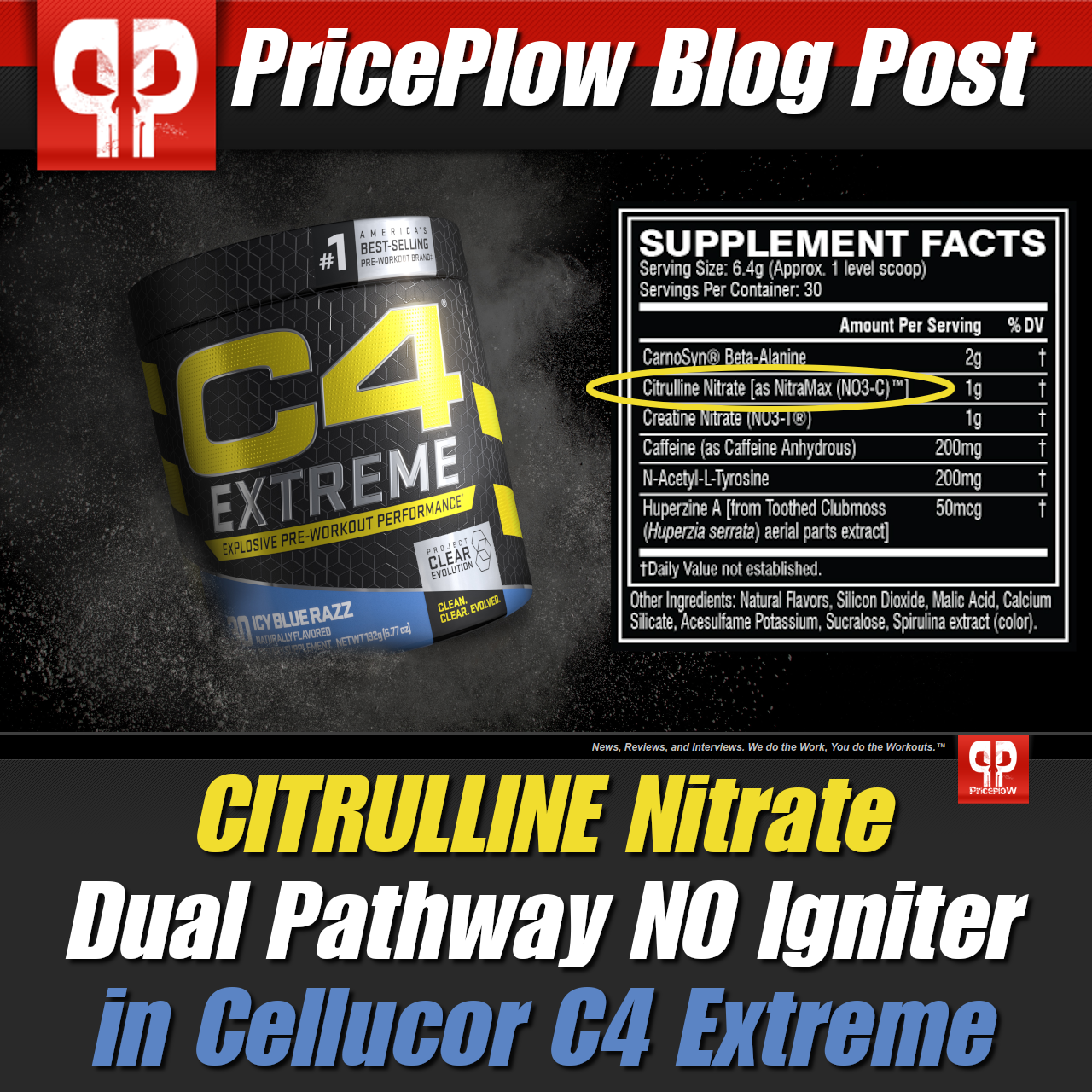
A pre workout ingredient that boosts nitric oxide while it boosts nitric oxide? Count us in for the strength and pumps!
Yes, to this day, we still are in the process of discovering ingredients, and formulating new ones, that can improve our training! In fact, there’s a relatively new ingredient that we’ve been introduced thanks to advancements made in science - citrulline nitrate! We’ve been finding this stuff more frequently these days, specifically in formulas coming from Cellucor, one of the industry’s leading brands. In fact, it’s one of the prominent ingredients in their new pre-workout, C4 Extreme, which features the patented version of citrulline nitrate, NitraMax (NO3-C).
Citrulline nitrate is intriguing, initially, because the two components that make it up are immediately recognizable - citrulline and natural nitrates! Both act as potent nitric oxide-boosting compounds, yet they work through two different pathways. Citrulline nitrate, though, combines them, offering a two-fronted attack on low nitric oxide levels!
In this post, we’ll tell you everything you need to know about citrulline nitrate - what it does, the pathways it operates in, what it can do for you, and even hint at a possible synergistic relationship between the two molecules! Before we go plunge into some science, be sure you’re subscribed to PricePlow for up-to-date supplement deals, news, reviews, interviews, and diet research!
Cellucor C4 Extreme – Deals and Price Drop Alerts
Get Price Alerts
No spam, no scams.
Disclosure: PricePlow relies on pricing from stores with which we have a business relationship. We work hard to keep pricing current, but you may find a better offer.
Posts are sponsored in part by the retailers and/or brands listed on this page.
But wait...what exactly is nitric oxide?
At first glance, the term "nitric oxide" might be easily mistaken for some sort of "boost" you can activate in an arcade video game. Although nitric oxide doesn’t make your computer-based race car go any faster, it does allow your body to function properly. In fact, nitric oxide is so vital to the body that it’s involved in almost all bodily processes! Due to its importance, the body actually has two different ways of producing this crucial molecule,[1] both of which come into play with citrulline nitrate.
Enzymatic - arginine and citrulline
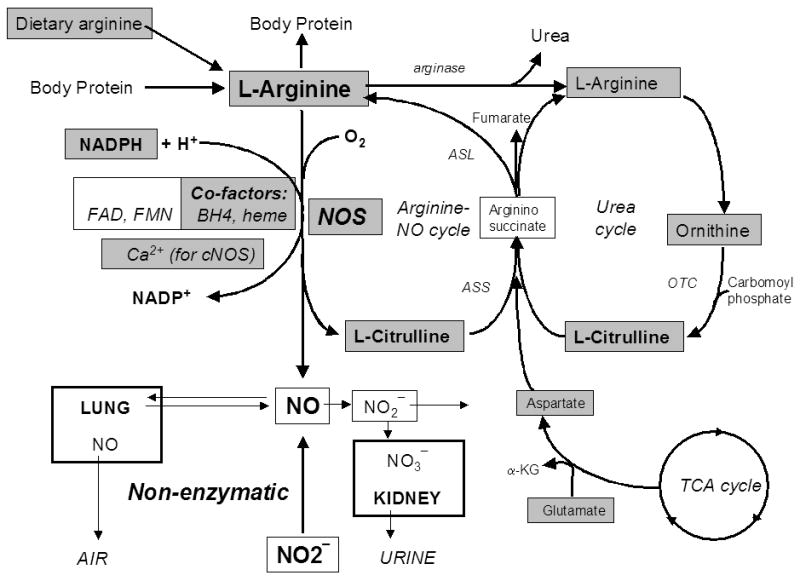
Schematic overview of the NO synthesis pathway, involving both enzymatic (via NOS; major pathway) and non-enzymatic pathways. L-arginine is converted to NO and citrulline in the presence of NADPH and oxygen.[1]
Despite being produced in different areas throughout the body, most nitric oxide (NO) comes via enzymatic processes. NO is the product of NO synthase (NOS), a series of chemical reactions that take place within the body.[2] With both oxygen and nicotinamide adenine dinucleotide phosphate (NADPH) facilitating the operation, L-arginine is broken down into L-citrulline and NO.[2] The byproduct of NOS, citrulline, has actually been shown to increase arginine levels,[3] suggesting this process repeats itself multiple times before there’s no more NO that can be made.
There are three different isoforms of NOS, each of which have a slightly different role within the body:
- Endothelial NOS (eNOS) - acts as a vasodilator, controls blood pressure.[4]
- Neuronal NOS (nNOS) - controls synaptic function, mainly regulates blood pressure within the central nervous system (CNS).[4]
- Inducible NOS (iNOS) - helps fend of inflammatory diseases and septic shock.[4]
Each of these isoforms of NOS depend on the same cofactors (NADPH, flavin adenine dinucleotide, flavin mononucleotide, and BH4),[4] and all yield the same final product - NO.
Non-Enzymatic - nitrates
While the enzymatic pathway is a bit more complex in terms of the substances involved in NOS, the non-enzymatic operation is much more straightforward!
Nitrates are organic compounds commonly found in a number of foods, with vegetables like spinach and beetroot often touted for their extremely high nitrate content. Once ingested into the body, though, these nitrates begin to work their magic. In a two-step, electron-stripping process, nitrate (NO3-) is reduced to nitrite (NO2-), which is then turned into nitric oxide (NO).[5] The true beauty of this NO-boosting pathway isn’t just its simplicity - its degree of self-sufficiency is pretty spectacular, as the only real limiting factor here is the amount of nitrates available for breakdown.
The discovery of this pathway is relatively new, especially when compared to how long science has known about the enzymatic pathway. That’s precisely why high-nitrate supplements have grown over the past couple of decades.
So, now that we’ve covered how the body produces nitric oxide, let’s get into what this resultant product can do!
How it relates to exercise
As we’ve said, NO is involved in virtually every bodily process. However, that doesn’t mean that it’s equally important. There are actually a few key functions of NO, and other than regulating blood pressure or helping treat Type 2 Diabetes,[6,7] they happen to be related to exercise!
Understanding how NO and exercise performance are linked isn’t all that difficult when you take a step back. If NO is responsible for vasodilation, opening up blood vessels to increase blood flow, and regulating blood pressure, then it should be able to maximize blood flow while training. Not only would this increase the blood flow to working muscles, but it would also enhance the transportation of both oxygen and nutrients, effectively keeping your muscles fueled with what they need. If only...
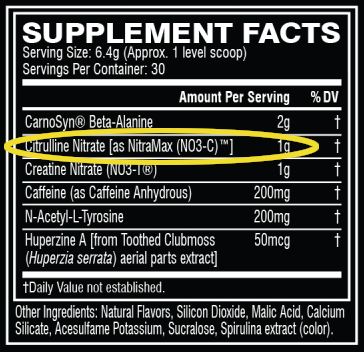
Cellucor C4 Extreme's new ingredient label. Citrulline Nitrate is one of the most powerful NO boosters we've seen.
Well, that theory is actually fact - research has found that exercise training performance and increased NO production have positive correlation,[8] which means that more NO can help improve your training! Elevated NO levels are clearly beneficial, making methods of increasing NO all the more appealing!
Inducing NO production - nitrates and citrulline
When it comes to boosting NO production, the two most effective supplement ingredients we have are citrulline and nitrates! The first operates within the enzymatic pathway, while the latter calls the non-enzymatic pathway home. Yet despite their difference in methods, they actually have shown similar exercise-enhancing benefits!
Citrulline (benefits, studies, etc.)
Citrulline is a nonessential amino acid, which means it’s either found via diet or produced by the body. Research has shown that its one of the best NO boosters in the industry,[9] with science even identifying it as a better option than arginine![10] This is incredibly interesting, and sort of goes against what you’d expect. However, arginine is not as bioavailable as citrulline, and is often broken down too quickly to even yield results.[11] When it comes to citrulline, though, here’s just a taste of what science has found:
- Better O2 uptake and high-intensity exercise performance![12]
- Increased time to exhaustion - one study from 2010 found a 52.92% increase in training repetitions on the bench press.[13]
- Less muscle soreness - research from 2010 saw a 40% decrease in post-training muscle soreness.[13]
The effects of increased blood flow are evident here - with more oxygen and more nutrients reaching the muscles, they’re able to go longer, perform better, and recover more efficiently! Who wouldn’t want some more of any of that in their training?
You can find citrulline in a variety of supplements, regardless of its form - its sometimes bonded to other substances to alter absorption rates, as is the case in citrulline malate. Either way, your body ultimately yields the pure amino acid, giving you the benefits we mentioned above. The clinical dose of pure citrulline is anywhere from 3g to 6g per day, which equates to slightly more if taking a bonded form of the ingredient!
Nitrates (benefits, studies, etc.)
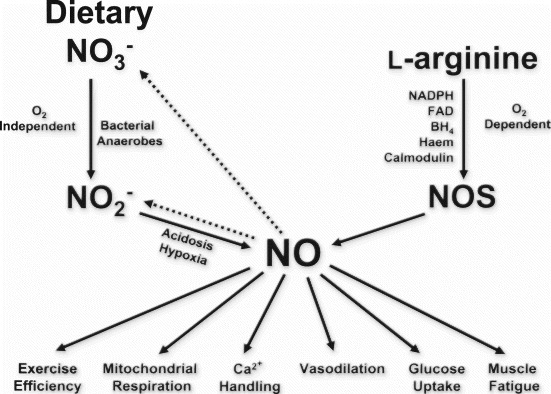
The pathways of nitric oxide (NO) generation in humans. The right branch of the schematic represents the conventional L-arginine-NOS-NO pathway while the left branch of the schematic represents the NO3−-NO2−-NO pathway.[5]
It should come as no surprise when we tell you that nitrates are just as effective at enhancing NO levels as citrulline. Research on nitrates is a bit more recent compared to its similarly-acting cousin, but is just as convincing:
- Increased time to exhaustion - a meta-analysis of 17 studies concluded nitrates can significantly reduce fatigue in recreationally active individuals.[14]
- Improved endurance - meta-analysis found a positive increase in endurance exercise capacity.[15]
Oddly enough, getting enough nitrates is somewhat easier than getting adequate amounts of citrulline. Sure, you can take nitrates specifically, or even consume them in foods. However, there are other supplements out there that deliver auxiliary nitrate-linked NO production. Things like beetroot powder (often used for betaine, a power-enhancing ingredient) or a greens powder can pack additional nitrates you weren’t expecting to get!
Clearly, these two are quite effective on their own. However, thanks to things like patented TM NitraMax (NO3-C) technology, the industry has begun utilizing a NO-booster that combines both of them for maximum results!
How about both?!
With two pathways that can create NO, there are multiple ways one could pursue increased NO levels. We’ve even highlighted two ingredients that can help do just that, one for each specific pathway. However, there’s definitely potential in operating via both pathways simultaneously, even further boosting NO production!
Companies have begun experimenting with a more advanced compound, one that works through both NO-boosting mechanisms. NitraMax (NO3-C), a patented version of citrulline nitrate, has been at the forefront of this innovation, with companies like Cellucor introducing it into their products. Based on preliminary research, we can definitely see why they like it so much!
A two-fronted effort
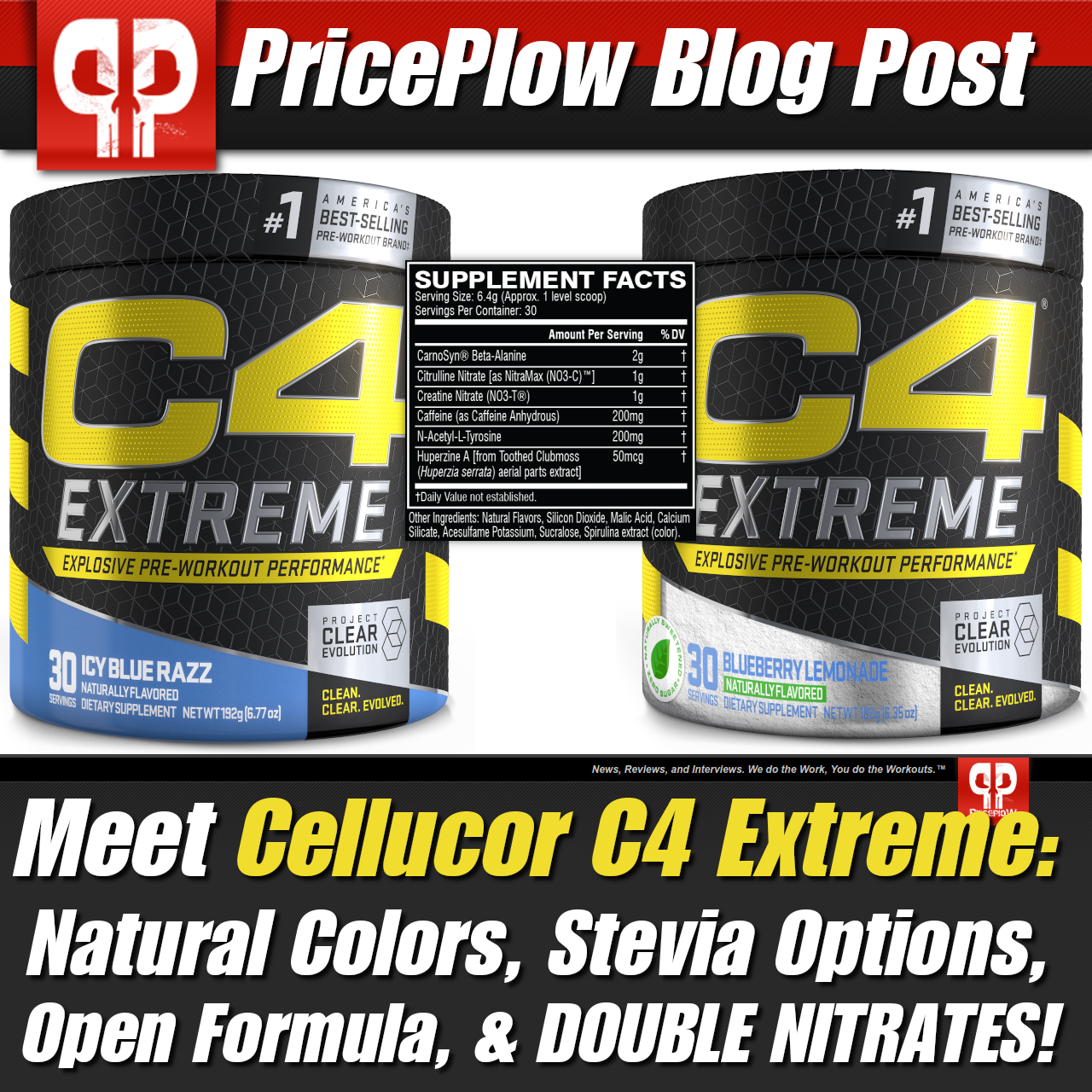
...and Citrulline Nitrate isn't even the only nitrate / pump ingredient in Cellucor C4 Extreme!
There isn’t too much out there in regards to studies involving citrulline nitrate, given the novel nature of the compound. However, there are a couple of studies that are promising, and lead us to believe there’s some real potential here.
A study from 2016 administered an acute 8mg/kg dose of nitrates to 12 young adult subjects who had already been taking 3g/day of citrulline for a long period of time. They measured the subjects’ blood pressure and vascularity before and after nitrates became involved. They found that both increase vascular blood flow and decrease blood pressure, noting an additional nitrate-linked boost in vascularity post-exercise.[16] This study was also sure to highlight the increases when both ingredients were at play, rather than just one or the other.
Research published in 2017 took a slightly different look - these scientists were interested in the effects of acute nitrate and citrulline supplementation in post-ischemic vascularity of healthy subjects. Subjects were either given both nitrates and citrulline or a placebo, and performed a 2-leg occlusion test. They found that the group which received both supplements had greater post-ischemic vasodilation, likely due to more NO being produced via the stimulation of both pathways.[17]
Again, the tandem has performed extremely well in early research. Obviously, we’d love to see more published results, but still, you can’t deny the promise here!
Potential synergy?
There may be a bit more to this story, however. As it turns out, there’s some evidence of a potential synergistic relationship between citrulline and nitrates. It has to do with one preventing the body from growing tolerance to the other!
Nitrate tolerance - it’s real!
Building a tolerance to nitrates is a real problem, one that shows its face often within the medical field. Nitrates are commonly used to help treat ischemia and angina due to the compound’s blood flow-enhancing properties. However, there have been many cases where the effectiveness of dosages vary due to growing dependence within patients.
The earliest case of such a tolerance comes from 1888, when a man using a nitrate-based medication required 20 "grains" to reach the same effects he once had at an initial 1/100 "grain" dose![17] That’s an incredibly extreme increase, and while it doesn’t directly relate to pure nitrates, it nonetheless suggests a potential issue. Recent research has begun to identify different causes of nitrate tolerance, most of which revolve around the degradation of enzymes and receptors that had previously been more receptive.[18]
Nitrate tolerance is loosely akin to caffeine tolerance - if you use a certain dose for a prolonged period of time, you’ll eventually reach a point where you need to take a higher dose to yield the same effects that were once associated with the lower dose. Despite this reality, there may be a way to help fend off this dependency, and it comes from the arginine-citrulline NOS pathway!
Can the arginine-citrulline NOS pathway actually ward off nitrate tolerance?
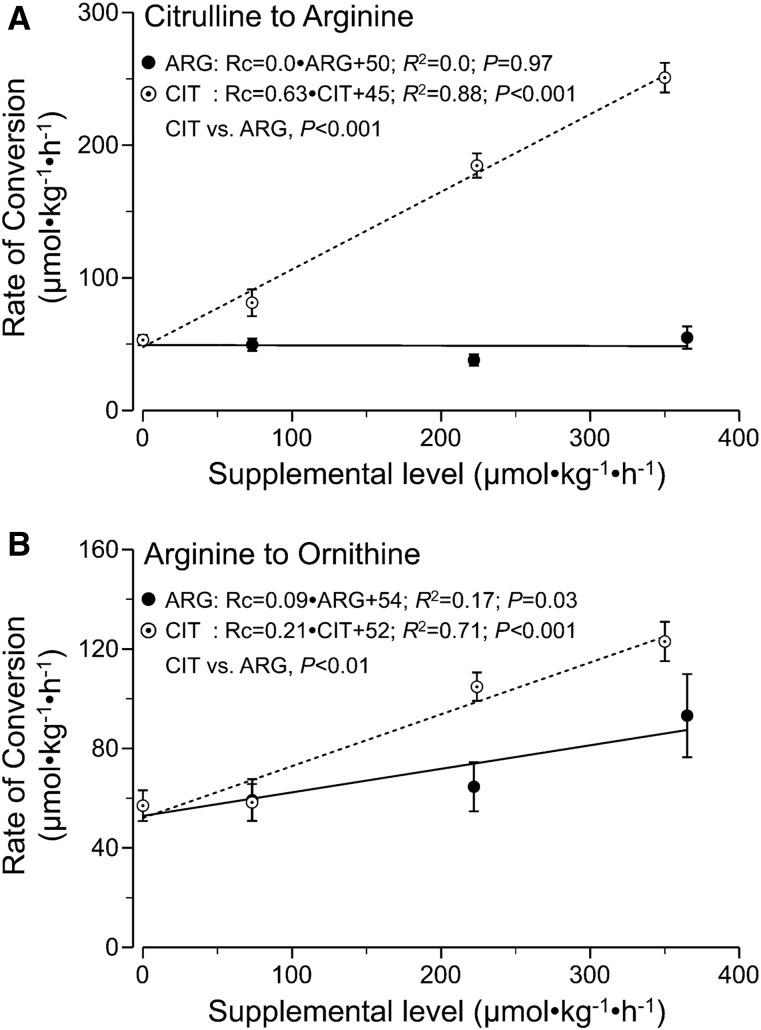
Rc of citrulline to arginine (de novo arginine synthesis) (A) and circulating arginine to ornithine (B) in mice infused intragastrically with a dextrose/amino acid mixture containing different amounts of CIT and ARG.[11]
There has been research that suggests that nitrate tolerance can be prevented by arginine.[19] Essentially, this study said that if enough arginine is present within the blood, then nitrate absorption won’t be affected. However, the findings are quite controversial. There are components of this study that are contradictory to previous findings in science,[20,21] which has thus created debate as to whether a synergistic relationship exists at all.
While the jury is still out on this, the fact that there’s a potential positive relationship, yet no negative association, is pretty great if you ask us. There’s no downside to taking citrulline nitrate, only upside - they work NO production from 2 sides, and may even compound the other’s effects!
Citrulline Nitrate - best of both worlds!
Regardless of sphere of fitness you fall into - a "pump-chasing" bodybuilder, a performance-focused weightlifter, or just someone training recreationally - there’s a place for an advanced vasodilator like citrulline nitrate. Taking a two-pronged approach to the generation of nitric oxide, this ingredient can really ramp up NO production, resulting in improved blood flow, performance, and recovery.
This novel ingredient is just beginning to find its way onto the market, and we can thank Cellucor for carrying a lot of that weight. They’ve long touted its potential, and have finally identified an ideal version of the compound for their products. Look for citrulline nitrate NitraMax (NO3-C) in their products, such as C4 Extreme, for what just may be the best pump-inducing, training-enhancing NO production booster we have in the industry!
Cellucor C4 Extreme – Deals and Price Drop Alerts
Get Price Alerts
No spam, no scams.
Disclosure: PricePlow relies on pricing from stores with which we have a business relationship. We work hard to keep pricing current, but you may find a better offer.
Posts are sponsored in part by the retailers and/or brands listed on this page.
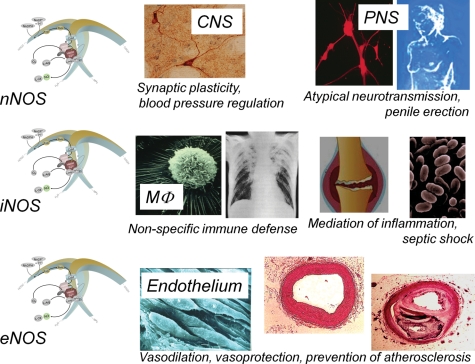
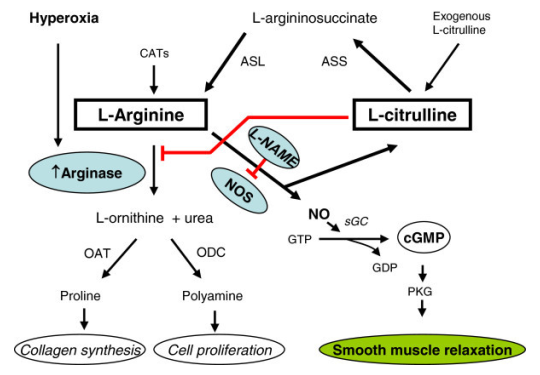

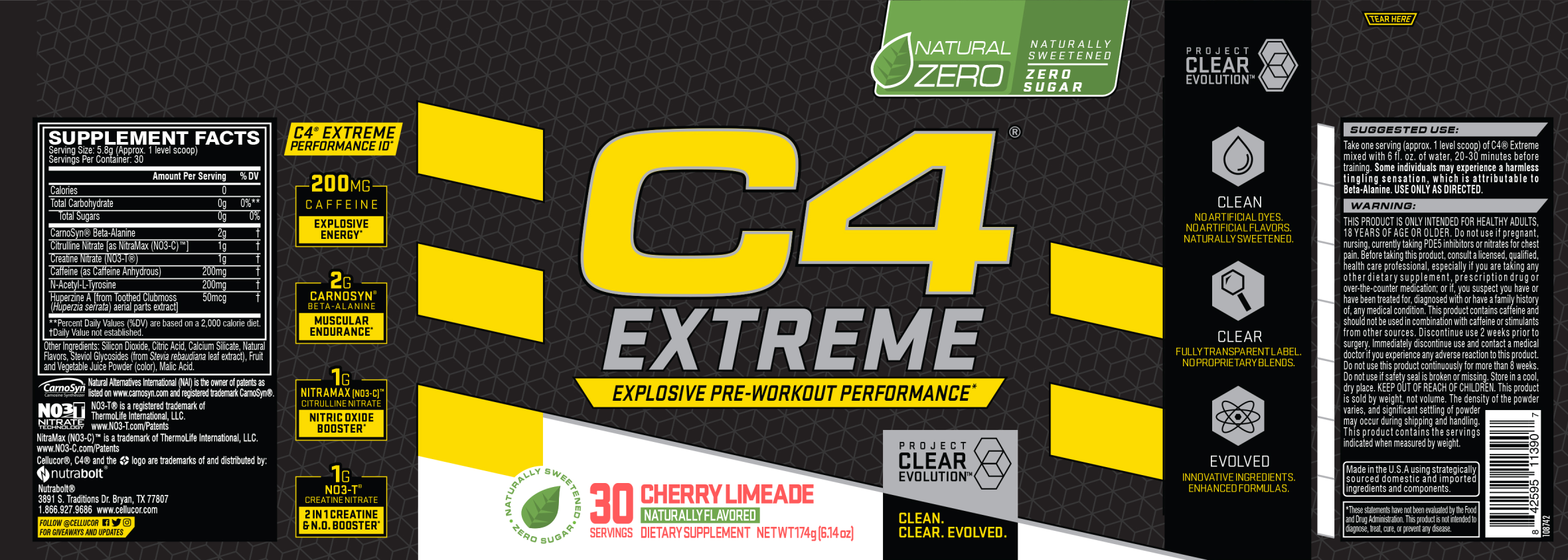


Comments and Discussion (Powered by the PricePlow Forum)